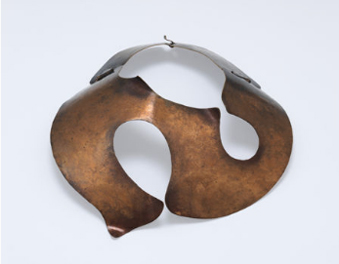The Body Transformed Examines the Purpose and Power of Jewelry
A new exhibit at New York’s Metropolitan Museum of Art explores how jewelry acts upon and activates the body it adorns, featuring several stunning examples of rare copper and brass pieces of jewelry art spanning the centuries.
 Copper bracelet, 1949. Gift of Jacqueline Loewe Fowler, 2010.
Copper bracelet, 1949. Gift of Jacqueline Loewe Fowler, 2010. Photograph by Art Smith.
Jewelry: The Body Transformed, on view through February 24, features a collection of 230 objects curated almost exclusively from The Met collection. Artifacts include metal headresses, earrings, brooches and belts, necklaces and rings, spanning from 2600 B.C.E. to today. Works are displayed alongside relevant sculptures, paintings, prints, and photographs to provide a truly contextual experience for viewers, amplifying the transformative experience of the jewelry itself.
“Jewelry is one of the oldest modes of creative expression—predating even cave painting by tens of thousands of years—and the urge to adorn ourselves is now nearly universal,” commented Max Hollein, Director of The Met. “This exhibition will examine the practice of creating and wearing jewelry through The Met’s global collection, revealing the many layers of significance imbued in this deeply meaningful form of art.”
The exhibition was made possible by Albion Art Co., Ltd. Ming Chu Hsu, Lulu and Anthony Wang, the Diane W. and James E. Burke Fund, Diane Carol Brandt, the Druckenmiller Foundation, Galerie Magazine, and Barbara A. Wolfe. The collection showcases jewelry from around the world, grouping ornaments according to the part of the body they adorn: head and hair; nose, lips, and ears; neck and chest; arms and hands; and waist, ankles, and feet.
The remaining galleries are organized thematically into 5 categories historically spanning from 2600 B.C.E. to today. Groupings include The Divine Body, examining one of the earliest conceptions of jewelry and its link to immortality, The Regal Body, examining the use of jewelry throughout history to assert rank and status, The Transcendent Body, focusing on how jewelry is used to traverse the temporal and spiritual realms, The Alluring Body, exploring how jewelry engenders desire, and The Resplendent Body, exploring the marriage of material and technique for the purpose of ostentation.
“To fully understand the power of jewelry, it is not enough to look at it as miniature sculpture,” states Melanie Holcomb, Curator, Department of Medieval Art and The Cloisters. “While jewelry is ubiquitous, the cultures of the world differ widely regarding where on the body it should be worn. By focusing on jewelry’s interaction with—and agency upon—the human body, this exhibition brings in a key element that has been missing in previous studies of the subject.”
To kick off the exhibit, the museum is hosting several talks and workshops throughout January and February. Met curators will discuss the context and function of personal adornment in the lecture series “Jewelry Seen and Unseen.” on Jan. 30, Feb. 6 and Feb. 13, at 11 a.m. Met curator Beth Carver Wees and corporate archivists Annamarie Sandecki of Tiffany & Co. and Levi Higgs will speak about “Jewelry Icons of New York” on Feb. 3 at 2 p.m. The museum will also host free hands-on art-making workshops for children ages 3 to 11 on Jan. 13, from 1 p.m. to 4 p,m, and a teen studio on Jan. 26, from 1 p.m. to 5 p.m.
Resources:
Also in this Issue:
- Copper King’s Art Collection Plays Role in Montana's History
- Fisher Forging His Way Into Homes
- Money Museum Showcases Million Dollar 1943 Cent
- The Body Transformed Examines the Purpose and Power of Jewelry
- San Antonio Zoo Raises Awareness of White Rhino Extinction with Iconic Bronze Sculpture
